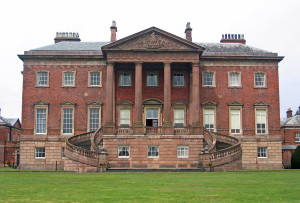 I love to feature new authors! I love it so much I gave up my blogging day to tell you about No Conventional Miss by Eleanor Webster. No Conventional Miss is Eleanor’s first published book and I’m delighted Harlequin Historical took her on! You see, Harlequin Historical has tended to back away from paranormal elements in their line, but they’ve taken the plunge with No Conventional Miss!
I love to feature new authors! I love it so much I gave up my blogging day to tell you about No Conventional Miss by Eleanor Webster. No Conventional Miss is Eleanor’s first published book and I’m delighted Harlequin Historical took her on! You see, Harlequin Historical has tended to back away from paranormal elements in their line, but they’ve taken the plunge with No Conventional Miss!
Here’s the backcover blurb for the book:
She’s always been different…
Amaryllis Gibson is an unlikely debutante. She favors fact over fashion, cares not for “proper” conversation and is haunted by ghostly visions which could land her in the madhouse! Marriage is definitely the last thing on Rilla’s mind…
But when she’s caught in a compromising position with Viscount Wyburn, suddenly she finds herself betrothed! And worse, his powerful presence only increases her visions. By shedding light on the viscount’s past, can Rilla gain his trust and win him round to her more…unconventional traits?
 And some Goodreads reviews!
And some Goodreads reviews!
“…the perfect book to read at Hallowe’en if you like just a touch of spookiness mixed in with your historical romance.”
“…well-researched and emotionally gripping.”
“The author has spun a tale which kept my attention from beginning to end.”
Eleanor has generously agreed to give away a signed copy of No Conventional Miss to one lucky, chosen-at-random commenter from North America or the UK.
So here she is! Welcome, Eleanor!
Tell us about No Conventional Miss?
Thank you for inviting me to Risky Regencies, Diane.
The protagonist, Rilla, is a fascinating and unusual character. She is an inventor. She has a keen interest in force, momentum and any number of ‘unladylike’ activities. However, she has always been plagued with moments of second sight and rejects this aspect of herself. Indeed, a maternal aunt had been institutionalized for similar traits. A part of Rilla’s interest in the scientific is that this will serve to subdue that mystic element within her nature.
Paul is also conflicted. He believes love to be destructive based on his mother’s suicide which he thinks was caused by his parents’ unhappy marriage. Therefore, he has little interest in marriage and even less in love.
But a scandal forces the match and Rilla faces her greatest fear as she is increasingly haunted by Paul’s mother’s ghost,
The question is; can Paul and Rilla work through these challenges and achieve acceptance of self and each other or will these challenges destroy them?
This is your first book! Tell us about your writing journey and “The Call”.
My writing journey has been long, like two decades! I’m a multi-tasker which has both positive and negative aspects. I believe that one seldom has sufficient time to properly commit to one’s long term goals and, if one waits for that perfect moment, one can procrastinate into ‘never’. Therefore, each day I put aside time, however small, to write,
The downside – it took 18 years. On the flipside, I eventually made it.
‘The call’ felt surreal. I live in Canada and my editor is in England, so we had to communicate via e-mail to ensure that it wouldn’t happen at 2 a.m. Therefore, I had a good idea what was coming!
However, I believe I had quite the mega-grin at my day job that morning.
What is risky about No Conventional Miss?
No Conventional Miss is a departure from the traditional Harlequin historical because it involves a paranormal element. In fact, I was advised somewhere along my journey to remove that element from the plot as it did not fit with the traditional regency.
I have gladly accepted a lot of feedback during this journey. It is how I have learned and grown as a writer. However, this did not feel right and, although I knew it kindly meant and from a knowledgeable source, I chose not to take it. I felt that to remove it would take away that spark. In any element of life, it is a risk and takes courage to know when to take feedback and when to follow one’s own path.
Did you come across any interesting research when writing your book?
Yes, absolutely! As I described Rilla’s inventions, I wondered whether any ‘real-life’ Regency woman might be similar to Rilla. Then I found Sarah Guppy (1770-1852). Sarah was born in Birmingham and patented numerous designs. Indeed, she achieved considerable financial success, earning a contract from the British Navy worth £40,000 for a device to prevent the growth of barnacles on ships. And then there is my personal favorite; Sarah’s invention of a tea or coffee urn which also cooked eggs and warmed toast.
What is next for you?
I have a two book contract with Harlequin so a second book will be released at some point… This is set slightly earlier with the backdrop of the French Revolution.
And now a question for the readers–If you could chat with any Regency hero or heroine from any book, who would you choose and why?
Answer the question or just make a comment and you’ll be in the running for a signed copy of No Conventional Miss! (selection will be made after midnight Weds, Oct. 7)












